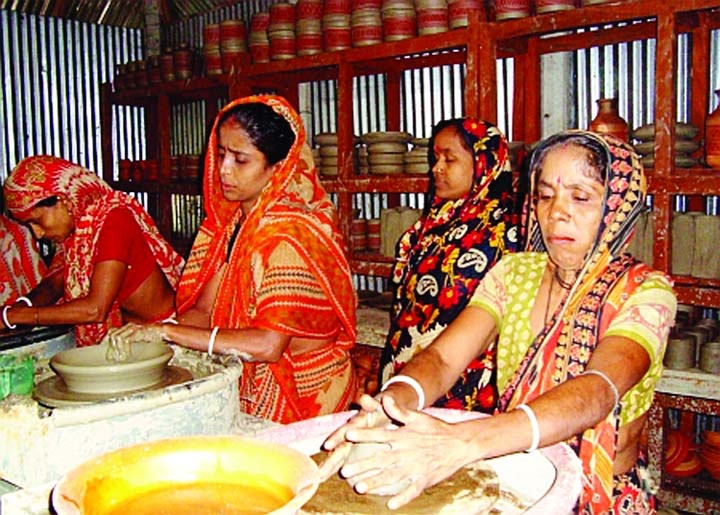
BSS, Dhaka :
The contribution of underprivileged and uneducated women in the country’s national economy is immense, especially their involvement in handicraft industry is commendable. A woman is considered as the skilled workforce for the handicraft industry.
On the other hand, pottery side by side with the handicraft industry bears the cultural heritage of the country. The women are involved with the industry since the ancient time and their contribution in this sector can not be denied even in the modern age.
Pottery is very ancient in Bangladesh. The places like Paharpur of Rajshahi, Mahastangarh of Bogra and Moinamoti of Comilla bears the testimony of pottery. Many antiques from 3rd century to 13th century have been discovered there.
Besides, Kantazir Temple in Dinajpur is another important place for the pottery. Different ancient temples inscribed with the terracotta art works scattered across the country is the unique example of the pottery.
Pottery is one of the oldest and most widespread of the decorative arts, consisting chiefly of functional objects made of clay and hardened with heat. Those who are involved with the works are called potters. Pottery, mostly a tradition of family-based business, is run by with participation of both male and female.
Pottery is divided into three categories-earthenware, stoneware and porcelain. Stoneware, made of clay and dried in sun, is fired at a high temperature to cause it to vitrify and harden and potters are the bearers of it. After fired, potters use different colours in stoneware objects like vessels, vases, plates, and bowls to make those more attractive. The objects are sold in bazaars across the country along with showcasing those in rural fairs.
Earthenware objects are sold whole the year in front of the Shishu Academy in the capital city. The objects come from the suburban areas of Rayerbazar, Kaliakoir, Fulpar and Manikganj. Besides, those are also collected from Patuakhali, Rajshahi, Shariatpur and Comilla. Women have been putting their endeavors in this trade from primary to finishing stage of the objects.
Among the women labourers, about 90 percent are uneducated and they have no training. Like other sectors, the women workers are also facing wage discrimination. They draw two-third portion wage compared to their male counterparts investing the same labour.
Now-a-days, pottery objects are losing its credibility to the plastic goods due to its uses viability and cost efficiency. On the other hand, as the plastic goods can be recycled, the producers concentrate their mind in producing plastic goods instead of the pottery business. Nonetheless, the demand of pottery is high in the country as the pottery objects like vessels, vases, plates, and bowls can be seen in all houses’ drawing room to kitchen of rich and poor. The objects also are being exported abroad due to its artistic value.
Clay, the main component of pottery, is available in the riverine Bangladesh what is very rare in the West Bengal of India. As a result, the prospect of pottery in Bangladesh is quite well.

